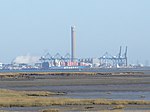Allhallows-on-Sea railway station
1932 establishments in England1961 disestablishments in EnglandDisused railway stations in KentFormer Southern Railway (UK) stationsPages with no open date in Infobox station ... and 4 more
Railway stations in Great Britain closed in 1961Railway stations in Great Britain opened in 1932Transport in MedwayUse British English from August 2015

Allhallows-on-Sea station was the railway station for Allhallows-on-Sea, Kent from 1932 to 1961. It was opened partly on the 14 and fully on 16 May 1932. It had an island platform with a run-round loop. Originally the branch from Stoke Junction was single track, but it was doubled in 1935, and singled again in 1957. The station closed on 4 December 1961 and was demolished in 1975, although the listed water tank remains.
Excerpt from the Wikipedia article Allhallows-on-Sea railway station (License: CC BY-SA 3.0, Authors, Images).Allhallows-on-Sea railway station
Geographical coordinates (GPS) Address Nearby Places Show on map
Geographical coordinates (GPS)
| Latitude | Longitude |
|---|---|
| N 51.47234 ° | E 0.65417 ° |
Address
ME3 9QT , Allhallows
England, United Kingdom
Open on Google Maps









